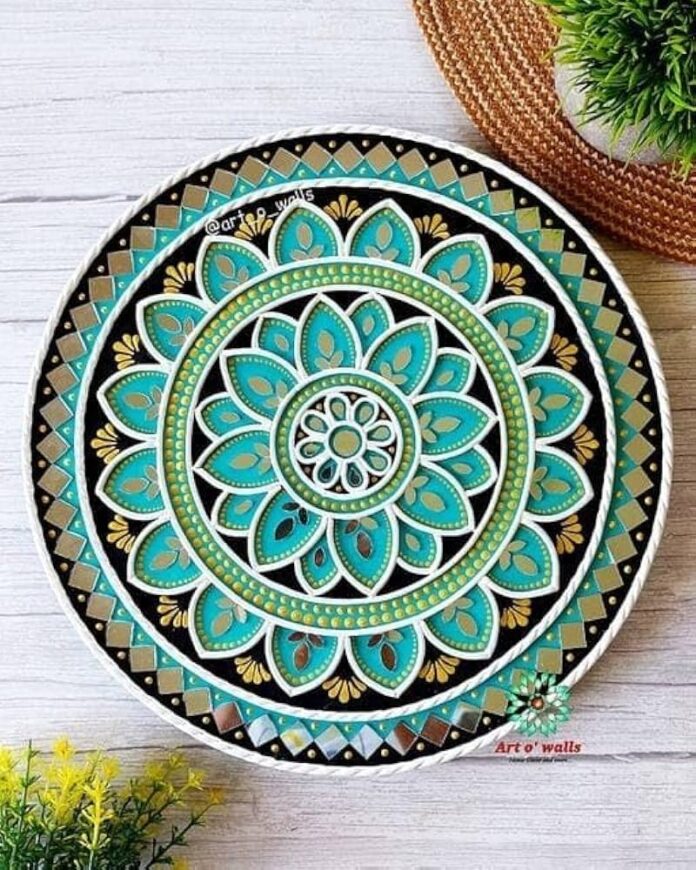lippan art for beginners
Originating in Gujarat’s Kutch region, lippan art is a stunning and traditional kind of Indian wall art. It is distinguished by the creation of elaborate, textured patterns on surfaces such as walls, doors, and even furniture using clay and mirrors. Homes and ceremonial areas are frequently decorated with lippan art, sometimes called lippan kaam. Because it blends artistic methods, cultural legacy, and creativity, mastering this craft can be a fulfilling experience for novices. This post will walk you through the fundamentals of Lippan art if you’ve never done it before and want to learn more.
Knowing the basic supplies needed for the craft is crucial before beginning Lippan art for beginners. The primary substance used to create designs is clay, which is applied on a surface. Water is frequently added to the clay to make it smooth and workable. Mirrors are an essential component of Lippan art in addition to clay. The clay patterns have tiny mirrors incorporated within them, which give them a reflected element that heightens their beauty. As their confidence grows, beginners can go to more intricate motifs from a simpler design, like simple geometric patterns or flowers.
The equipment required to create Lippan art is rather easy to use and readily available. A pencil for drawing your design before applying the clay, plastic sheets or stencils for producing crisp lines, and a spatula or knife for smoothing and shaping the clay are other necessary supplies. Having glue and mirror bits on hand is also useful for adding reflected components to your design. Before trying larger walls or spaces, it’s preferable for novices to practise on smaller surfaces, such as canvas or wooden boards. This will help you hone your talents and obtain a sense of the methods.
The next stage is to plan your Lippan art design after you have acquired the necessary supplies and equipment. Start with a straightforward design as a novice, like a simple flower theme or a circle pattern. Start by using a pencil to softly sketch your design on the surface. Once the sketch is complete, cover the area with a thin layer of clay and start moulding it into the pattern you want. Make sure the design is clean and well-defined by using your spatula to smooth out the clay. The method calls for patience and accuracy, so take your time.
Adding the mirrors is the next stage of the procedure. Small round or square mirrors are a nice place to start for novices. While the clay is still wet, insert the mirrors into the design, gently pressing them into place to make sure they are secure. Strategic placement of the mirrors throughout the design will produce a harmonious, eye-catching appearance. Before beginning the painting process, let the clay thoroughly dry after the mirrors are in position. Patch up any places where the clay might have cracked or grown uneven while drying, if necessary.
It’s time to paint your pattern after the clay has dried and the mirrors have been firmly positioned. Lippan art typically uses vivid, striking hues like red, yellow, green, and blue, but you can also choose colours that complement your home’s decor or your own personal style. For brilliant colours and long-lasting effects, use acrylic paints. To make your Lippan art come to life, carefully apply paint throughout the design and around the mirrors. Before putting your work on display, let the paint completely dry. You may develop your abilities and even produce increasingly complex pieces as you practise and try out various designs over time.
To sum up, learning Lippan art is a great method to discover Indian traditional craftsmanship and hone your artistic abilities. You can make beautiful wall art that showcases your creativity and cultural heritage with just a few simple materials and techniques. Lippan art provides a distinctive and satisfying means of self-expression, whether you’re learning a new hobby or decorating your house. You can begin with basic designs and work your way up to larger pieces and more intricate motifs as you gain skill, eventually becoming an expert in this lovely art form.




